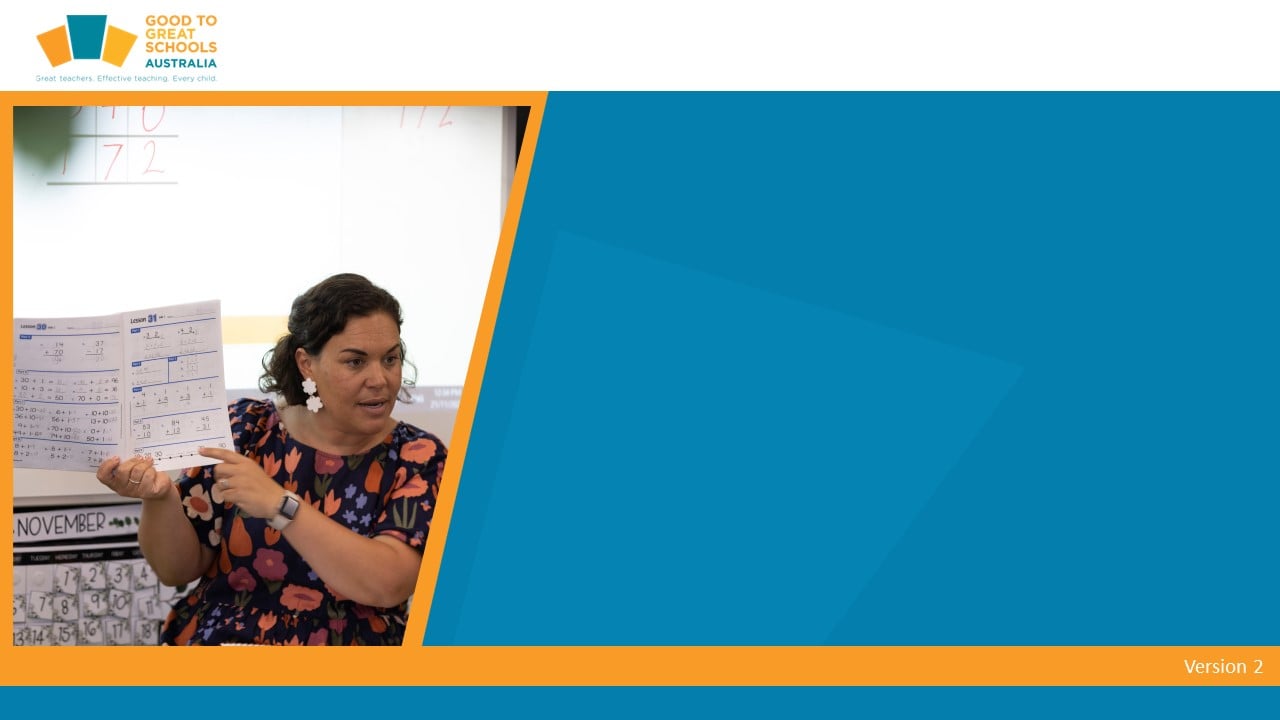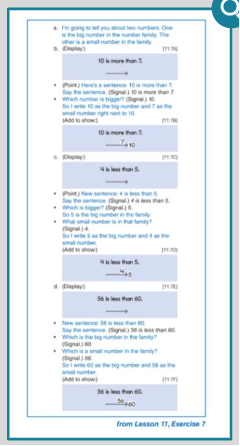Teach Connecting Math Concepts C (3)
-
Module Introduction5 Topics
-
Overview20 Topics|2 Tests
-
Cover
-
Lesson Objective
-
Opening the Lesson
-
Professional Learning Standards, Techniques, and Practices
-
Major Features of Direct Instruction
-
CMC-C Overview
-
CMC-C Materials
-
CMC-C Scope and Sequence
-
Time Requirements
-
Check Your Understanding
-
CMC-C Placement Testing
-
Video: CMC-C Placement Test Video
-
Grouping Students
-
Seating Arrangements
-
Using a Script
-
Video: Following a Script Video
-
CMC-C Board Work
-
Test Your Understanding
-
Review
-
Lesson Completed!
-
Cover
-
Connecting CMC to Oz-e-maths Program19 Topics|2 Tests
-
Cover
-
Lesson Objective
-
Opening the Lesson
-
Professional Learning Standards, Techniques, and Practices
-
Why Oz-e-maths?
-
Instructional Design of Oz-e-maths
-
Program Components – Oz-e-maths
-
Oz-e-maths Lessons
-
Video 3 – Oz-e-maths Video
-
Check Your Understanding
-
Student Workbooks
-
Oz-e-maths Assessments-Independent Practice
-
Oz-e-maths Mastery Tests
-
Mastery Test Procedures
-
Mastery Test Scenario
-
Video 4 – Oz-e-maths lesson
-
Test Your Understanding
-
Review
-
Lesson Completed!
-
Cover
-
Signals and Introduction to Counting, Place Value and Number Families21 Topics|2 Tests
-
Cover
-
Lesson Objective
-
Opening the Lesson
-
Professional Learning Standards, Techniques, and Practices
-
Signals Used in CMC-C
-
Using an Audible Signal
-
Video 5 – Audible Signal
-
Using a Visual Signal (Point-Touch)
-
Video 6 – Point-Touch Signal
-
Counting Track Progression
-
Counting Exercises
-
Check Your Understanding
-
Place Value Track Progression
-
Place Value Exercises – Teaching Techniques
-
Number Families Overview
-
Video 7 – Teaching Number Families
-
Number Families with Letters
-
Teaching Number Families Scenario
-
Test Your Understanding
-
Review
-
Lesson Completed!
-
Cover
-
Word Problems Track and Corrections19 Topics|2 Tests
-
Cover
-
Lesson Objective
-
Opening the Lesson
-
Professional Learning Standards, Techniques, and Practices
-
Word Problems Overview
-
Comparison Word Problems with Two Numbers
-
Comparison Word Problems with One Letter
-
Comparison Word Problems with Two Letters
-
Check Your Understanding
-
Correcting Errors
-
Correcting Errors Scenario
-
Video 8 – Lesson with Corrections Video
-
Introduction to Start-End Word Problems
-
Teaching Start-End Word Problems
-
Classification Word Problems
-
Video 9 – Teaching Start-End Word Problems
-
Test Your Understanding
-
Review
-
Lesson Completed!
-
Cover
-
Column Addition/Subtraction and Multiplication20 Topics|2 Tests
-
Cover
-
Lesson Objective
-
Opening the Lesson
-
Professional Learning Standards, Techniques, and Practices
-
Learning Facts
-
Column Addition and Subtraction Overview
-
Teaching Techniques
-
Column Addition with Carrying
-
Column Subtraction Process
-
Video 10 – Column Subtraction Video
-
Check Your Understanding
-
Multiplication Overview
-
Multiplication Procedure for ‘Count-by’ Problems
-
Multiplication Analysis for Finding the Area
-
Multiplication Problems with Missing Factors
-
Individual Turns
-
Video 11 – Individual Turns
-
Test Your Understanding
-
Review
-
Lesson Completed!
-
Cover
-
Money and Measurement18 Topics|2 Tests
-
Cover
-
Lesson Objective
-
Opening the Lesson
-
Professional Learning Standards, Techniques and Practices
-
Overview of Money Track
-
Introducing the Dollar Sign and Decimal Point
-
Converting Large Cents Values and Word Problems
-
Money Word Problems
-
Corrections
-
Video 12 – Teaching Money Word Problems
-
Check Your Understanding
-
Measurement Track
-
Teaching Area
-
Transivity
-
Video 13 – Transivity with Letters
-
Test Your Understanding
-
Review
-
Lesson Completed!
-
Cover
-
Geometry and Fractions19 Topics|2 Tests
-
Cover
-
Lesson Objective
-
Opening the Lesson
-
Professional Learning Standards, Techniques and Practices
-
Overview of Geometry Track
-
Three-Dimensional Shapes
-
Shape Decomposition
-
Angles
-
Check Your Understanding
-
Video 13- Geometry Lesson
-
Correcting Behaviour Errors
-
Correction Procedures for Behaviour Errors
-
Introduction to Fractions
-
Teaching Fractions
-
Video 14- Fractions
-
Correction Scenario
-
Test Your Understanding
-
Review
-
Lesson Completed!
-
Cover
-
Motivating Students and Increasing Engagement21 Topics|2 Tests
-
Cover
-
Lesson Objective
-
Opening the Lesson
-
Professional Learning Standards, Techniques and Practices
-
Effective Teaching
-
Motivating and Engaging Students
-
Teaching Rules and Expectations
-
STAR Rules
-
Teacher-Student Game
-
Check Your Understanding
-
Video 15 – Teacher-Student Game
-
Reward Systems
-
Specific Praise
-
Video 16 – Praise
-
Affirmations
-
Video 17 – Affirmations
-
Script Practice
-
Effective Teaching
-
Test Your Understanding
-
Review
-
Lesson Completed!
-
Cover
-
Mastery Tests and Independent Work21 Topics|2 Tests
-
Cover
-
Lesson Objective
-
Opening the Lesson
-
Professional Learning Standards, Techniques and Practices
-
Introduction to Mastery Tests
-
Scoring Mastery Tests – Part One
-
Scoring Mastery Tests – Part Two
-
When to Provide Remedies
-
How to Provide Remedies
-
Remedy Scenarios
-
Video 18 – Providing Remedies
-
Check Your Understanding
-
Using Data to Inform Instruction
-
Using the Student Progress Tool to Record Data
-
Video 19 – Using the Student Progress Tool
-
Cumulative Tests
-
Independent Work
-
Group Work Check of Independent Work
-
Test Your Understanding
-
Review
-
Lesson Completed!
-
Cover
-
Module Completion Survey1 Topic
Participants 541

CMC-C Board Work
Many exercises require problems to be displayed on the board or a screen. The word ‘Display’ appears in the script if a display is to be shown to the students. ‘Add to show’ appears in the script if something is added to the existing display.
The CD comes with the ‘CMC-C’ Teacher Presentation Book and has all the displays and additions or changes to the displays.
The Board Display CD contains all the displays for every lesson. The displays are labelled with a display code on the CD and in the lesson exercises. The lesson is indicated by the first number in brackets, then the exercise number, followed by the letter that indicates the order of the display for the exercise, for example [24:1A].
Teachers write most of the displays on the white board. When the word ‘Display’ appears in the script, this means the teacher writes what appears in the script on the white board. See example below.



